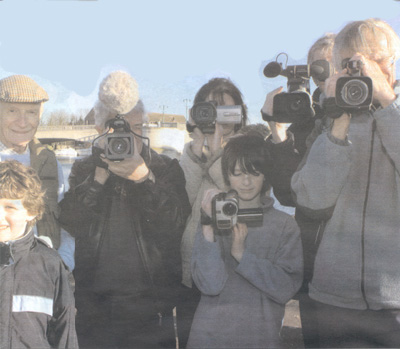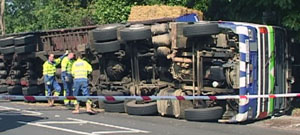MORE INFOArchive2018 Obituary |
2006 | ||||||||||||||||||
 
|
| Making it in the movies | ||||
| They sit In darkened rooms and watch
moving images, and then talk about what they've seen. ALEC KINGHAM caught up with Reading Film and Video Makers during one of their competition film screenings |
||||
|
garage where he hosts film nights - his wife appeanng as an usherette to serve |
"There were just six of us to start with," he recalled. "It built up to 10 in the first |
||
| When I amved at St Andrew's
Church hall in Caversham, where the Reading Film and Video Makers
(RFVM) meet regularly, the premises were locked and I could here
muffled voices emerging from within. Upon admission, I was ushered
into a darkened room where it seemed a predominantly male group
were watching a motion picture that featured a lot of women in bikinis.
Quite a few shapely bottoms later, the movie finished and the lights
went on to reveal something actually quite innocent. Around 35 film
enthusiasts were judging a selection of DV videos in the annual
RFVM Cume Awards. This particular film, of Miami Beach bums, curiously titled Copthorne Hotel was among 12 entries that included subjects as diverse as a steam train ride, a wedding, autumn leaves and the aftermath of a lorry crash. The rules stated that each submission must be only four minutes long. Neil Hodgson, RFVM committee member, and one of two judges for the competition, explained that the club hold several competitions throughout the year. These cover different categones, from holiday footage to documentary, fiction and a one-minute challenge. "Films are judged on different criteria," he said. "Sometimes they're selected for their innovation, if they're pushing the boundaries. "We have a novice night too, to encourage new members." The annual Currie Award was named after RFVM member Don Currie, who introduced the four-minute competition 20 years ago. Don submitted two entries to the competition this year, although he stated quite modestly before the results were announced, "I'm sure that I'm not going to win." A keen film buff, Don has a cinema set up in his |
ice creams during interval!
The eventual third place Cume Cup winner, About Diabetes was perhaps
the most professional looking of the 12 screened on the competition
night. Beginning with a sophisticated graphic, it switched quite
suddenly to another rear view - that of a doctor, a moment of weak
editing perhaps - before continuing with a summary of how Type II
diabetes affected the sufferer. The video, which wouldn't have looked out of place in an NHS training workshop, included interviews with nursing staff. However when a nurse began to jiggle a vial of 'sticky' diabetes affected blood like a cocktail shaker, the blood drained from my own head and I began to feel quite faint. I was relieved the documentary was only four minutes long. Second prize went to Silly Beggars footage of 'living statue' buskers taken over several years in Palma, Bruges, Milan and Amsterdam with a dry and hilarious narrative. It was clearly made as part of a humorous holiday video. The film that won the 2006 Currie Cup was titled Woodcote Road by Laurie Joyce, who came upon a straw-laden lorry that had rolled onto its side on a busy road in Reading. He incorporated imaginative angles to cover the cleanup operation. Not all of the RVFM dabble in filmmaking as a hobby. Chairman Geoff Addis declared: "A number of our members are actually doing it commercially. We've got a very wide membership, from kids just out of school to an Oxford graduate. We very much welcome young blood. "A number of our members have won quite prestigious prizes and international awards. Other clubs ask us to judge their ompetitions." Alan Lott, at 83, the oldest member of RFVM, was one of the original founders, establishing the club in his Caversham lounge in March 1957. |
year and got a bit
much for my house, so we moved to a room over the Abbey Gateway, which was cold in winter and had a steep flight of stairs to lug the projection equipment up.'We used to do a lot of ordinary tape recording edited with standard 8 films." Lott, who prefers working in 16mm film, only received his first digital video camera last Christmas. He still occasionally contributes material to the RFVM nights, and has the honour of a documentary film he completed in 1963, of an archaeological dig at Cox Green near Maidenhead, included in the National Film Archives. The footage includes what he believes was the world's first aerial survey of an archaeological site, a practice now commonly used prior to excavations. Phil Martin says some of the work he has undertaken includes a study of the reintroduction of Red Kites to the Chilterns. This native raptor was shot to extinction in England by farmers and was reintroduced from Spain in 1990. There are now more than 300 breeding pairs. He also made a quirky documentary on the Maharajah's Well in Stoke Row, paid for by the Maharajah of Benares in 1864. The wealthy Indian funded the digging of the 368-foot deep well after he heard about the plight of villagers whose water supply had run dry. Now, in a twist of history, the video is being sold by the charity Water Aid, and has raised more than £1,000 to fund clean water projects in India and Africa.
|
||
 DRAMATIC: Still from the winning video at the Currie Awards of a lorry accident by Laurie Joyce |
 |